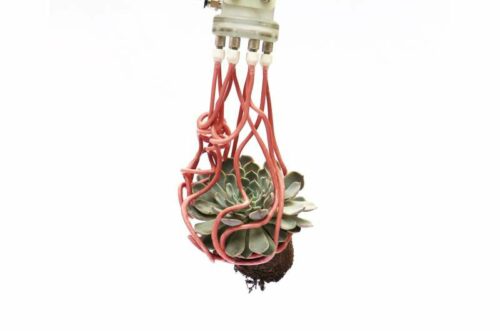Researchers from Massachusetts have developed a soft robotic gripper that includes a collection of thin tentacles to easily grab any type of objects

Presently, robotic grippers depend on embedded sensors, complex feedback loops, or advanced machine learning algorithms, also need the operator’s skill to control the gripper to grasp fragile or irregularly shaped objects. Researchers from the Harvard John A. Paulson School of Engineering and Applied Sciences (SEAS) have developed a simpler way to accomplish this difficult task. They designed a new type of soft, robotic gripper that uses a collection of thin tentacles to entangle and trap objects, similar to how jellyfish collect stunned prey. The gripper depends on simple inflation to wrap around objects, and there is no need for sensing, planning, or feedback control. The gripper’s strength and adaptability come from its ability to entangle itself with the object it is attempting to grasp. The foot-long filaments are hollow rubber tubes. One side of the tube has thicker rubber than the other, so when the tube is pressurized, it curls like a pigtail or like straightened hair on a rainy day.
“This new approach to robotic grasping complements existing solutions by replacing simple, traditional grippers that require complex control strategies with extremely compliant, and morphologically complex filaments that can operate with very simple control,” said Wood, the Harry Lewis, and Marlyn McGrath Professor of Engineering and Applied Sciences and co-corresponding author of the paper. “This approach expands the range of what’s possible to pick up with robotic grippers.”
Even if the individual contact of the gripper is weak, which ensures protection of fragile objects from any damage while holding, the collective hold is very strong as the thin tentacles’ curls knot and entangle each other and the object. Each entanglement increases the strength of the hold. The object is released from the gripper by simply depressuring the filaments. The researchers conducted simulations and experiments to test the efficacy of the gripper, picking up a range of objects, including various houseplants and toys.
“Entanglement enables each highly compliant filament to conform locally with a target object leading to a secure but gentle topological grasp that is relatively independent of the details of the nature of the contact,” said Mahadevan, the Lola England de Valpine Professor of Applied Mathematics in SEAS, and of Organismic and Evolutionary Biology, and Physics in FAS and co-corresponding author of the paper.
This research could be implemented in real-life applications to grasp soft fruits and vegetables for agricultural production and distribution, delicate tissue in medical settings, and even irregularly shaped objects in warehouses, such as glassware.
Click for the Published Research Paper and Demo Video







